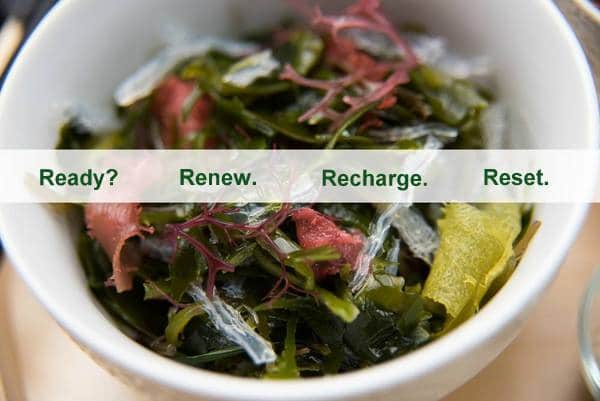 Okay…the holidays (including Martin Luther King Day!) are officially over.
Okay…the holidays (including Martin Luther King Day!) are officially over.
If you overindulged during the holidays (and into January) and find yourself struggling to get back to your “normal” eating routine; or, you feel challenged to make healthier food and lifestyle choices in the New Year of a New Decade….
…it’s time to consider a post-holiday cleanse.
Let me be clear, I am not talking about a detox-in-a-box or other magical elixirs that purport to help you shed weight effortlessly and boost your energy.
A cleanse is not just about drinking green juices, a water fast, or semi-starving yourself for a period of time. Done properly, a whole foods-based cleanse supports the five organs—the liver, kidneys, gut, lungs and skin—that process and eliminate toxins from the body. A cleanse also helps reduce inflammation.
What make us “toxic”?
In our modern, high-stress world, we are exposed to more environmental toxins through our food, water, environment and lifestyle in one day than our grandparents were in an entire lifetime! Sources of toxins include pesticides, herbicides and parasites in soil, food, and water; heavy metals (like lead) and other industrial chemicals in makeup, nail polish, hair dyes, shampoos and other personal care products; taking multiple medications; additives, preservatives, artificial colorings, flavorings and highly processed vegetable oils in processed/packaged foods; chemicals in solvents, plastics, and adhesives; toxins that our own bodies release under stress; and, even toxic thoughts and feelings that we may have….these all contribute to a state of ongoing stress, low energy, overweight / obesity and chronic disease.
What causes inflammation?
Physical trauma (e.g., a car accident, bad fall) and infections (e.g., Lyme Disease) are obvious causes of inflammation. Everyday sources of chronic, low-grade inflammation, however, can sneak up on us: nutritional deficiencies; excess sugar consumption; a sedentary lifestyle; regular exposure to hormone-disrupting chemicals; food sensitivities, toxic relationships; and too little sleep, among others.
Inflammation is often at the root of hormone imbalances (e.g., PCOS, hypothyroidism, low testosterone, endometriosis, etc.) and chronic diseases and conditions, including overweight / obesity, diabetes, autoimmune diseases, arthritis, heart disease and more.
Symptoms of toxic overload and inflammation
Signs that your body may benefit from a cleanse include:
- Bad breath
- Bloating, gas, constipation, and diarrhea
- Canker sores
- Excess weight and/or difficulty losing weight
- Fatigue and low energy
- Difficulty concentrating or brain fog
- Food cravings, especially for sugar and refined carbs
- Headaches
- Hormone imbalances
- Muscle aches, muscle fatigue, or joint pain
- Puffy eyes or dark circles under the eyes
- Postnasal drip and/or sinus congestion
- Frequent colds
- Skin conditions (e.g., acne, rashes, hives, eczema, rosacea, psoriasis)
- Sleep problems
- Mood swings, low mood, depression and/or anxiety
- Zero sex drive
A whole foods-based cleanse is gentle and can be done safely. It emphasizes eating seasonal, unprocessed whole foods. It also focuses on removing foods (and drinks, like alcohol and soda) that create inflammation in the body—sugar, flour, unhealthy fats, processed foods, pesticides and other hormone-disrupting chemicals—so that your organs can eliminate toxins efficiently. The combination of eating nutrient-dense foods PLUS removing inflammatory foods, is key to jumpstarting weight loss, increasing energy, balancing hormones and improving overall health.
My Unexpected “Cleanse”
Have you ever been so sick that when you came out on the other side…nothing tasted the same? This happened to me. My birthday is two weeks before Christmas, and for most of December, I strayed from my normal routine of eating mostly home-cooked meals. I was taken out for lunches and dinners, where I ate more of the foods that I love, but to which I am reactive, like coffee and chocolate. I also celebrated by making a homemade chocolate tiger nut flour birthday cake with chocolate ganache; it was so delicious that I ate a (large) slice several days in a row! My bedtime crept past the witching hour. As Christmas drew near, I felt uncharacteristically bloated, and my clothes felt uncomfortably snug. I vowed to do a cleanse—in January. But my body beat me to it!
On Christmas Day, I had zero appetite all day—even after a 6-mile walk in the frigid cold. Towards the end of that walk, I slipped on a sheet of black ice, smashing my knees and wrists. Luckily, no broken bones! Though stunned, I managed to crawl upright and limp home. Later that night, my fall triggered what had been brewing beneath the surface: the flu! My temperature never got above 99 degrees, but I had a runny nose, muscle achiness, blinding headaches; and, I was chilled to the bone even as I slept in three sweaters under a mountain of covers. The very thought of food made me nauseous, and I was unable to eat for several days. I slept 12 to 13 hours at a time. No phone. No computer. No television.
The upside of having the flu was that it forced me to rest in a way that I would not have otherwise. It also reset my body in a significant way. I lost several pounds as well as body fat. My insatiable 3PM craving for 95% dark chocolate disappeared. I had zero desire for sugar, wine, or even an occasional espresso (which I love). My appetite shifted dramatically. It is now impossible for me to eat mindlessly; when I feel full, I cannot eat another bite—even if I only have two or three bites left on my plate. I am eating simple, balanced home-cooked meals. I prioritize going to bed early. And, I sleep more deeply now since bidding adieu to caffeine.
The radical changes—in quality of sleep, appetite and cravings—helped me transition effortlessly to healthier lifestyle habits (e.g., no coffee, earlier to bed). Why? Because I experienced how good I could feel in a caffeine-free, well-rested body. When you do a whole foods-based cleanse, you are taking care of yourself in such a way that when you go back to what was “normal” (before your cleanse), it just doesn’t feel as good.
10 Cleanse Tips for a Healthy Reset
Following all or most of the tips below can help you get the most out of a cleanse. If, however, the idea of doing a cleanse feels overwhelming, feel free to check out my 7-Day Body Reset Cleanse, which offers two options: 1) Do It Yourself 7-Day Body Reset Cleanse and 2) Guided Cleanse (with my coaching support).
1. Commit to a cleanse mindset.
This means preparing for your cleanse mentally and physically. Decide how long you are going to do a cleanse: 7 days or 30 days? Plan a week’s worth of meals and the days you’ll prep and/or cook. Make shopping lists. Organize your pantry. Plan to slow down! Build plenty of downtime into your cleanse period to relax, rest and sleep.
2. Detox your mouth!
Digestion starts in the mouth. It makes sense, then, that oral health problems can be a symptom of digestive issues, including poor elimination.
Upon awakening, you will likely see a white coating on your tongue (a thick coating indicates higher toxicity). Scraping your tongue removes toxic build-up and bad bacteria that cause bad breath and/or affect gum health. Using a tongue scraper or a teaspoon, scrape your tongue—from back to front—5 to 10 times, rinsing off the spoon or tongue scraper between scrapes.
This can be followed by oil-pulling, a traditional Ayurvedic detox therapy in India. Swishing a fat-soluble oil, like sesame or coconut oil for 20 minutes, “pulls” toxins out of the mouth. Spit in trash (NOT sink!). Rinse. Brush and floss. Studies have shown that oil pulling—done regularly and combined with brushing and flossing—can effectively remove bad bacteria, improve bad breath, and reduce plaque (5). Studies have shown that oil pulling—combined with brushing and flossing—effectively removes bad bacteria, improves bad breath, and promotes healthy gums and overall oral health (1).
3. Drink water, ideally filtered.
Drinking lots of water, roughly half your body weight in ounces, helps flush toxins out through your pee. In the morning, drinking 16 ounces of warm water with fresh-squeezed lemon juice can help cleanse the liver and flush toxins out from the digestive tract (2). You’ll know you’re drinking enough water if your pee is a pale straw yellow or almost clear. Bottled water can contain toxins from its plastic packaging; whenever possible, choose glass-bottled water.
4. Take a break from all stimulants, including caffeine, chocolate, sugar and processed foods.
I know, I know…in winter, hot coffee feels like a non-negotiable morning ritual, and sugary treats and brightly packaged snacks tempt in the afternoon. Using stimulants to create artificial energy, however, is like whipping a horse when it’s already down—it might rally for a few last gallops, but, eventually, that horse will collapse—no matter how hard you whip it. In addition to being addictive, stimulants increase your stress hormones, deplete your vitamin and mineral stores, and interfere with sleep—this combination sets you up for weight gain, low energy and a weakened immune system. Instead: switch to an herbal tea, like peppermint or ginger; try a kale-banana “marathon” smoothie if you hit an energy slump mid-afternoon, and, instead of a packaged “healthy” snack (e.g., granola bar), choose whole foods (eg, olives, avocado, green juice, coconut milk yogurt) for real energy.
5. Be kind to your liver: Just say “NO” to alcohol.
The liver treats alcohol as a toxin. Excess alcohol consumption can put undue stress on the liver, a multi-tasking organ that works hard to filter out toxins from your blood. As alcohol is broken down in the liver, it produces potentially dangerous by-products, like acetaldehyde and free radicals, which can contribute to liver-related damage. Even if you are not an alcoholic or heavy drinker, you can experience fatty liver, a type of alcohol-related injury where fat is deposited in the liver—this can happen after a single drinking session (3)! Excess fat build-up in the liver can cause liver inflammation and, if unchecked, can lead to scarring and serious liver damage (4).
6. Remove common allergenic foods.
Roughly 80% of your immune system is in your gut. Eating foods to which you are sensitive triggers an inflammatory response in the gut, creating full-body inflammation that can manifest in any number of ways: bloating, constipation, joint aches, migraines, acne, even weight gain, among others. A cleanse, such as my DIY 7-Day Body Reset Cleanse removes common allergenic foods, like gluten, dairy, soy, peanuts and corn (you can eliminate potential trigger foods for 2 to 3 weeks if it feels good before reintroducing).
7. Eat raw and cooked leafy greens.
A poop a day keeps the doctor away—and prevents toxin build up in the body. To get your bowels moving, eat more greens, rich in insoluble fiber (aka “roughage”). Dark leafy greens, including kale, Swiss chard, collards, mustard greens and romaine, also contain an abundance of hard-to-get minerals, like magnesium, potassium, calcium and iron. Minerals are important basic building blocks for health. Including mineral-rich leafy greens at every meal supports healthy cell function, reduces inflammation and promotes detoxification (fiber helps move toxins and waste out of your body). Drink green juices. Add leafy greens to smoothies. Eat a substantial salad featuring plenty of leafy greens at lunch. Eat cooked greens at dinner.
8. Move your body daily.
After the holidays, a common New Year’s resolution is to “go to the gym more” and exercise more, longer and/or harder. As you experience detox symptoms (e.g., withdrawal from sugar, caffeine, processed foods) during a cleanse, you will have less overall energy. Pushing yourself to exercise harder and/or longer, while your body is trying to reduce its toxic load, further stresses the body and contributes to inflammation. During a cleanse, the movement in which you engage should be gentle, relaxing and restorative, such as walking, yoga or Pilates. A 20 to 30-minute bout of strength training (e.g., body weight workouts) can be beneficial, as long as it is neither long nor super intense.
9. Make quality sleep a priority.
Your body cannot repair, heal or properly detoxify without adequate sleep. Your body perceives chronic sleep deprivation as an ongoing stressor.5 According to a University of Helsinki study, sleep loss triggers an inflammatory response, causing biological changes to the immune system—some of which are long-term and may contribute to heart disease and type 2 diabetes (6). The bottom line: insufficient sleep suppresses immune system function, making it difficult to effectively fight off colds or bacterial infections. Aim for a solid 8 hours of sleep and be in bed no later than 11pm for optimal detoxification benefits.
10. Feel your feelings.
The body and mind are intimately connected. As you do a physical cleanse, uncomfortable emotions that you normally push away with sugar, caffeine, processed foods, alcohol or recreational drugs, may surface. When you are able to fully own and “digest” your feelings, you become less reactive to potential emotional triggers.
Keep a journal to track any physical and emotional symptoms that you experience during a cleanse. As uncomfortable feelings come up, write them down. It is important to notice what situations, places or people trigger you to react. (e.g., seeing your hyper-competitive successful sibling always triggers feelings of anger and resentment because you don’t feel “good enough”). Once you notice these feelings, it is important to understand WHY you feel a certain way. Is it really the other person’s fault? Or, perhaps, is the way that you feel rooted in fear, guilt, shame or anger with yourself—and you are projecting that feeling onto someone else? Once you become aware of your feelings, you have an opportunity to address them, whether through meditation; speaking your truth; releasing people from your life who deplete you; creating healthy boundaries around relationships, or deciding to work with a therapist.
Sources
1 Indian Journal of Dental Research. Jan-Mar, 2009, Vol 1, 47-51
2 European Journal of Pharmaceutical and Medical Research. May 2015
3, 4 National Institute on Alcohol Abuse and Alcoholism. Vol. 21, No. 1, 1997.
5 Pflugers Archive – European Journal of Physiology. Nov. 10, 2011
6 Science Daily. Oct. 23, 2013


